Memphis, Tennessee - Transfer Offices and the Terminal RPO
Copyright 2019-2022 by Bill Pollard
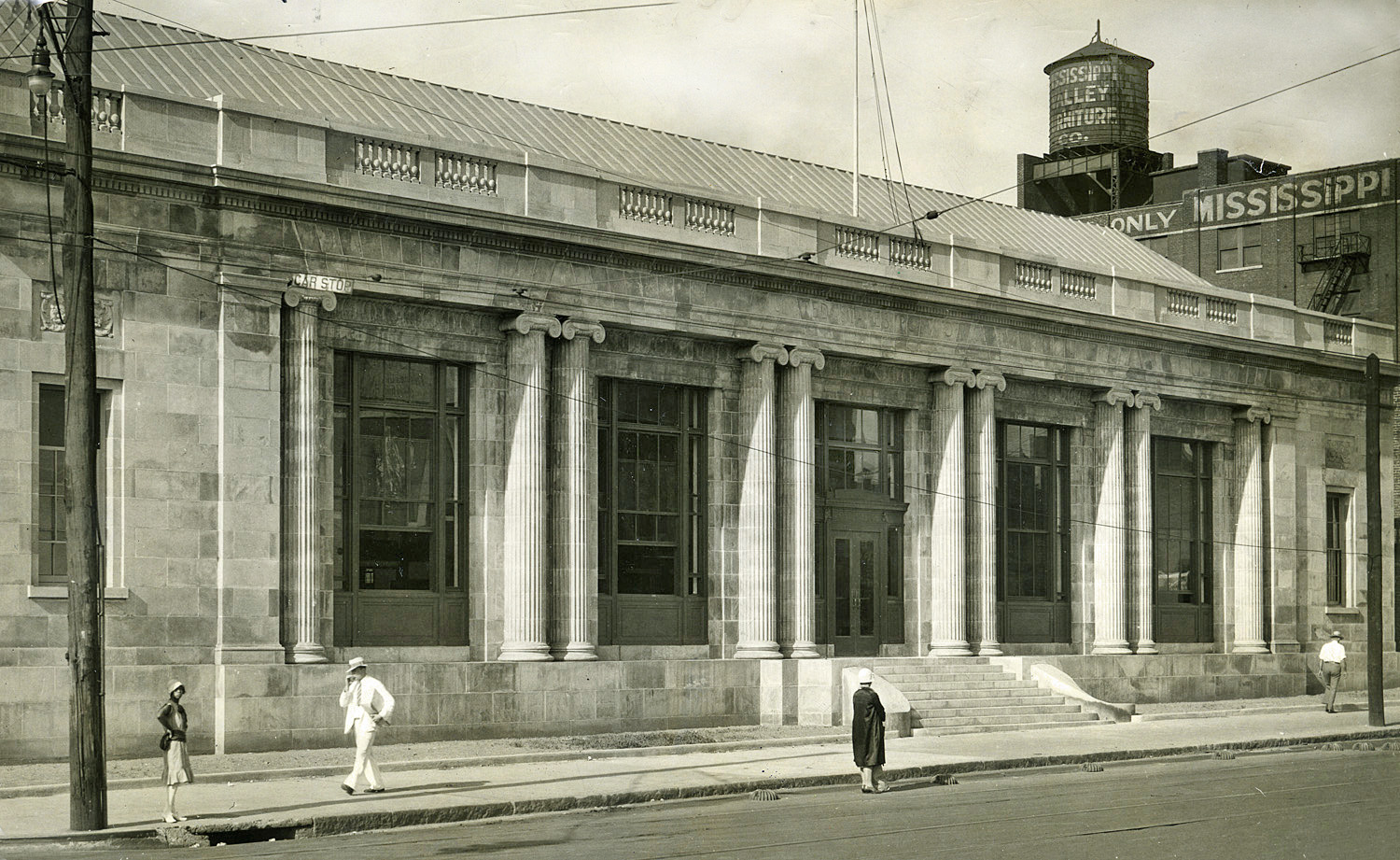
Memphis DeSoto Station post office, circa late 1920s.
This structure is situated at 161 East Calhoun, on the southwest corner of Calhoun Avenue and Second Street, a location which was just west of Memphis Union Station.
Photo courtesy of The University of Memphis Library, Special Collections.
Over fifty years after the last Memphis transfer offices closed, it has become increasingly difficult to provide reliable details on how these offices operated, and how they functioned as part of the Railway Mail Service (RMS). Much of the important documentation has disappeared, along with most of the employees who worked those jobs. Postal historians are left to summarize operations based on a sampling of Railway Mail schedules, a handful of postmarks and perhaps a few random postal forms. In the case of Memphis, former Mobile Post Office Society editor Hershel Rankin worked RPO lines and the transfer office in Memphis, but even those seemingly favorable circumstances did not result in any significant historical discussion of Memphis operations in society publications.
In the earliest days, Memphis had multiple passenger stations, but by the 1890s there was an ongoing public outcry for a single union station to simplify connections for passengers traveling over different lines. The elusive goal of a single station was never realized, but passenger train operations were eventually consolidated into two stations. Memphis Union Station opened on April 1, 1912 and served the Cotton Belt, Louisville & Nashville, Missouri Pacific, Nashville Chattanooga & St. Louis and Southern. Grand Central Station opened in October 1914, on the site of the former Calhoun Avenue station, and housed trains of the Illinois Central, Yazoo & Mississippi Valley, Frisco and Rock Island.
These two stations were located about three blocks apart, on Calhoun Avenue at the south edge of downtown Memphis.
Each station housed a RMS transfer office, and in 1913, the Memphis Terminal Railway Post Office was opened, adding yet another facility. With the later addition of the RMS/PTS (Postal Transportation Service) airfield operation and the PTS truck terminal, the postal historian has quite an assortment of postmarks to consider in Memphis. This article will hopefully provide some clarification about these operations and how they interacted with the numerous railway post office (RPO) routes serving Memphis.
On January 1, 1913, the Post Office Department began handling parcel post, competing with railroad express companies for smaller size packages. This service expansion resulted in a dramatic increase in mail volume which overwhelmed existing post office facilities nationwide. Memphis was no exception, and the Memphis postmaster soon requested emergency relief because the main post office floor space could not accommodate the volume of mail being handled. The main Memphis Post Office was located in the Customs House, an elaborate structure built in 1876 and situated on a bluff overlooking the Mississippi River near the northern end of downtown. This location, at 1 South Front Street, was over a mile north of the new Union and Central Stations, resulting in extensive mail haulage between the Post Office and the train stations. The chief clerk of the Railway Mail Service in Memphis was also located in the Customs House, an inconvenient arrangement for the more than 300 railway postal clerks arriving and departing from Memphis rail stations.
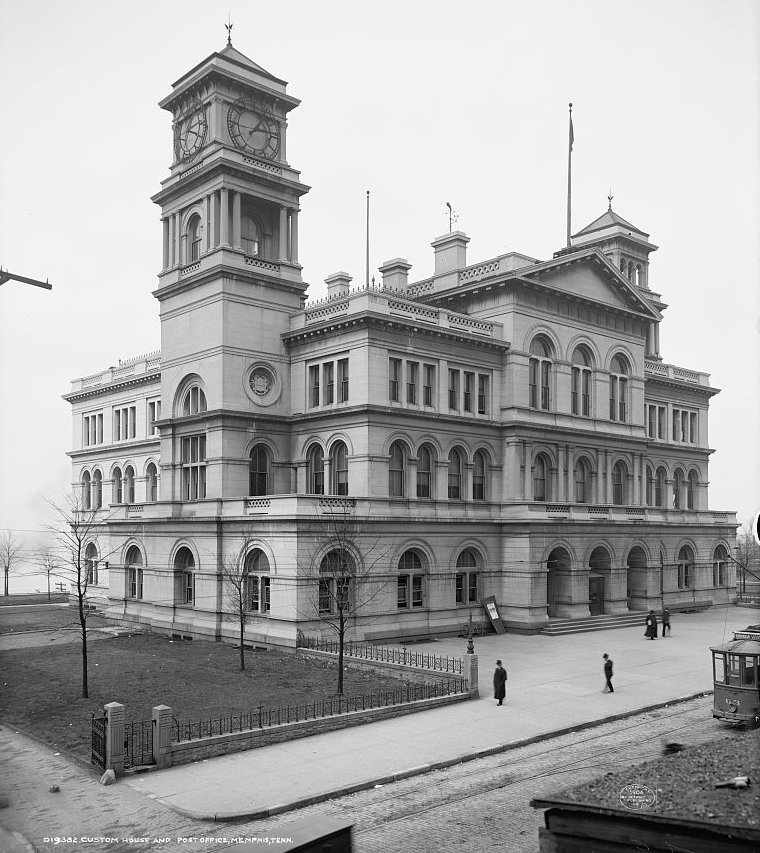
Memphis Custom House and Main Post Office
To alleviate the overcrowding, it was recommended that temporary quarters be rented for short-term relief, and that longer-range plans be developed for a large building on Calhoun or St. Paul Avenues in close proximity to the new railway stations. The Railway Mail Service planned to make Memphis a distribution point for parcel post and other matter for the States of Tennessee, Arkansas, Mississippi, Louisiana and Oklahoma. The necessity for the establishment of a terminal railway post office was already recognized by RMS officials, the only hindrance being the lack of room. Initial efforts to secure funding for a proposed one-story and mezzanine building of 1,500 square feet were unsuccessful; the building cost was estimated to be $250,000, with an additional $75,000 to purchase the site. In the interim, a large satellite Post Office, known as DeSoto Station, was established on the ground floor of the DeSoto Hotel, an existing structure on Calhoun Avenue.
The Memphis Terminal Railway Post Office opened on November 1, 1913, with a number of trained RPO clerks assigned to an office in the DeSoto Hotel. Memphis was one of the first few cities to receive a terminal RPO, along with Nashville and Chattanooga, although sixty to seventy other terminal RPOs were planned for other large railway centers across the country. Terminal RPOs were intended to ease congestion and delays from the volume of mail increase following the addition of parcel post. Also, in cases where RPO clerks had not finished sorting mail at the end of their run, the unworked mail could be transferred to the terminal RPO for final sorting and distribution.

Early examples of the Desoto Station machine cancel
Funding issues and World War I delayed construction of a dedicated post office building, and DeSoto Station continued to operate from leased facilities. During postal salary hearings before Congress on October 9-10, 1919, the testimony of John R. Warren, superintendent of DeSoto Station, provided background information explaining interactions with the Railway Mail Service.
- I am 40 years of age, and entered the Postal Service in February 1902 as a substitute clerk. In November 1913, I was selected to take charge of DeSoto Station. Currently (October 1919) I have 110 employees under my supervision, and this station will do close to $275,000 for 1919. There is no other branch post office in the south similar to DeSoto Station. In October 1915, we took over the Memphis Terminal RPO, and by this consolidation, effected a savings to the department of thousands of dollars annually.
- DeSoto Station is located in the heart of the wholesale business district and in the immediate vicinity of the Grand Central Station and the Union Station. The distribution of all outgoing mail is performed in this station and we distribute an average of 3,500 sacks of parcel post matter and 300,000 pieces other matter daily. DeSoto Station is the largest branch post office in the entire south doing terminal RPO work. DeSoto Station distributes solid carloads of parcel post matter shipped direct and unloaded from storage cars into this office. It also distributes solid carloads of catalogues shipped direct from New York and Chicago.
- DeSoto Station distributes "stuck" mail turned over by railway post offices centering at Memphis, and makes distribution of local mail for practically all RPO lines out of Memphis. DeSoto Station also distributes thousands of pieces of mail matter emanating from the various governmental departments in Washington for southern states, such as public documents, seeds, pension checks, etc.
- DeSoto Station has at present 13,000 square feet of floor space. We have asked for additional space and the matter has been favorably recommended by an inspector. The additional space needed will give us more than 20,000 square feet - making possibly the largest "branch" post office in the United States.
The DeSoto Hotel, DeSoto Station's original site, was located at 152 East Calhoun. By 1920, DeSoto Station had relocated to a larger facility at 36 East Calhoun while also continuing to house the Memphis terminal RPO. As mail volume and the Memphis distribution area increased, planning resumed for an entirely new DeSoto Station and a site was secured at 161 East Calhoun, immediately adjacent to Memphis Union Station. The new structure was designed with an elaborate fašade for the Calhoun street entrance, befitting the importance of this large branch post office and complimenting the architecture of the adjacent station. The new DeSoto Station opened on November 20, 1924, a 14,000 square foot facility which represented a significant expansion in the regional mail distribution system.
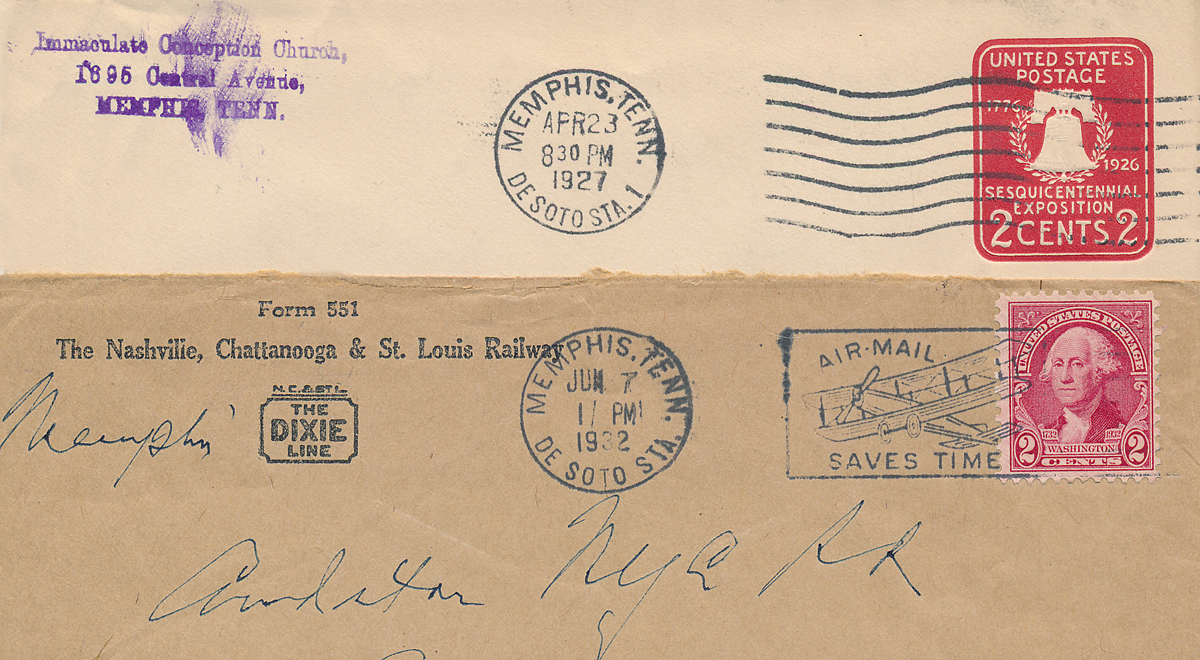
In the meantime, in July 1924 the Illinois Central Railroad awarded a contract to Ellington-Miller Company of Chicago, for the construction of a 300-foot by 67-foot brick and steel mail terminal just south of Central Station. Described as a "through mail terminal," this facility was designed to sort parcel post arriving at the Memphis distribution point before it was dispatched to its final destination. This terminal, which cost approximately $250,000, was leased to the Railway Mail Service as the new location for the Memphis Terminal RPO. The proximity of this building, located just west of the Illinois Central mainline, provided easy access for storage mail cars to be switched from Central Station to loading/unloading docks within the building. The initial lease was for 10 years, starting November 1, 1924, with 85 post office clerks and a small army of mail handlers who were classified as Illinois Central employees.
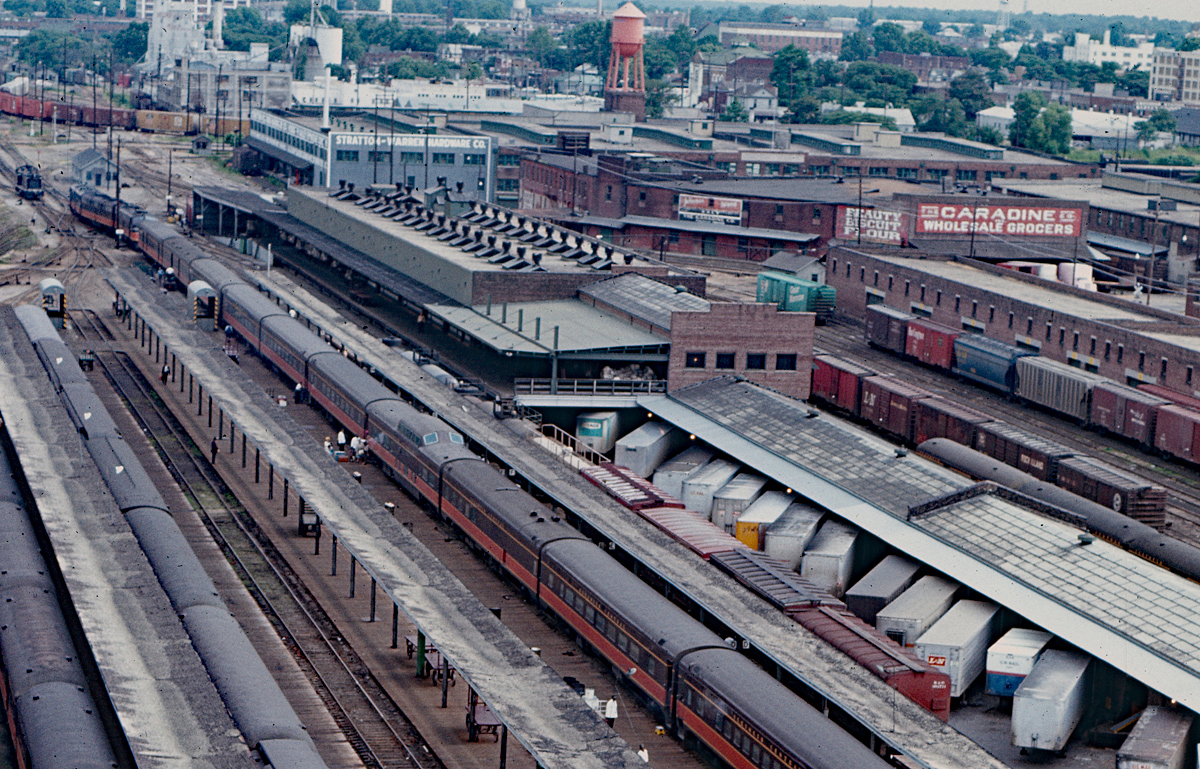
The new mail terminal which housed the Terminal RPO after 1924 is seen in this circa 1968 overhead view. The terminal is the elongated structure to the right of Illinois Central Train No. 1, the City of New Orleans. Note that the road power on Train 1 has cut away from the train, and will move south to clear the switch to allow the IC switch engine to remove the mail car and spot it at the Terminal. Even though RPO service for first class mail ended in September 1967, the IC continued to carry bulk mail between Chicago and Memphis into the early Amtrak era.
Photo courtesy of Terry Foshee.
Once the moves were completed into the new mail terminal at Central Station and the new DeSoto Station adjacent to Union Station, this arrangement continued for the next 35 years or so. In terms of the usage of postmarks, what does all this mean for the present day collector?
Transfer offices were maintained at both Central and Union Station, as had been the case at the Memphis rail stations which preceded these two facilities. In 1921, William Denning, Superintendent of the Railway Mail Service, provided this description of the responsibilities of the transfer clerk:
- The transfer clerk must supervise the loading and unloading of mail to and from trains. They do little physical handling of the mails, except for registered matter, with the other work handled by employees of the railroad. The transfer clerk must have an extensive knowledge of the separations of mails in order to direct the proper dispatch to various trains and connections. He must also monitor space allocations in baggage and mail storage cars, to see that the post office is not incurring expense unnecessarily, or in the case of excessive mail volume, order additional space or cars as needed to avoid delaying the mail.
From this relatively simple explanation, the duties of transfer clerks expanded over the years. By 1966, the duties, rules and regulations governing a transfer clerk required a 75-page book of instructions.
TRANSFER OFFICES
The earliest cataloged Memphis transfer office cancel is from December 31, 1913, and does not identify the station where the office was located. (At that date, there were three primary Memphis stations, Poplar Avenue, Calhoun Avenue and Union Station.) By 1914, RMS schedules provided a fairly detailed listing of transfer office hours and locations, and these documents confirm that transfer offices were open at both Central and Union Stations. The Memphis offices were included in the 12th Division schedules (Louisiana and Mississippi), rather than the 4th Division which covered most of the remainder of Tennessee. Transfer offices at both stations were generally open 6am-1am daily, or as needed to have personnel on hand for the arrival and departure of trains.
By 1940 if not before, the transfer office cancelling iron for Central Station had been redesigned to identify Central Station in the postmark. If there was a similar cancel iron for Memphis Union Station, no postmarks have yet been cataloged. With DeSoto Station being immediately adjacent to Union Station, it is possible that "stuck" mail from any inbound RPO at Union Station was delivered to DeSoto Station to be worked. In that case, mail needing a postmark would likely have received the DeSoto Station stamp. The Railway Mail Service became the Postal Transportation Service on October 1, 1949, and by 1955 or earlier, the RMS Central Station transfer office cancel was replaced with a PTS cancel, examples of which exist as late as 1965. The 1965 Central Station cancel is from a Pitney-Bowes R-55 roller type machine that was in use in 1955. The Central Station transfer office continued to be listed in PTS schedules through January 1968 but was closed by mid-year.
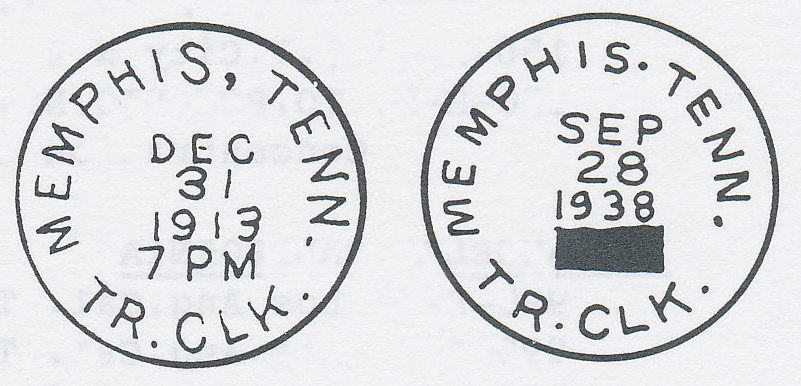
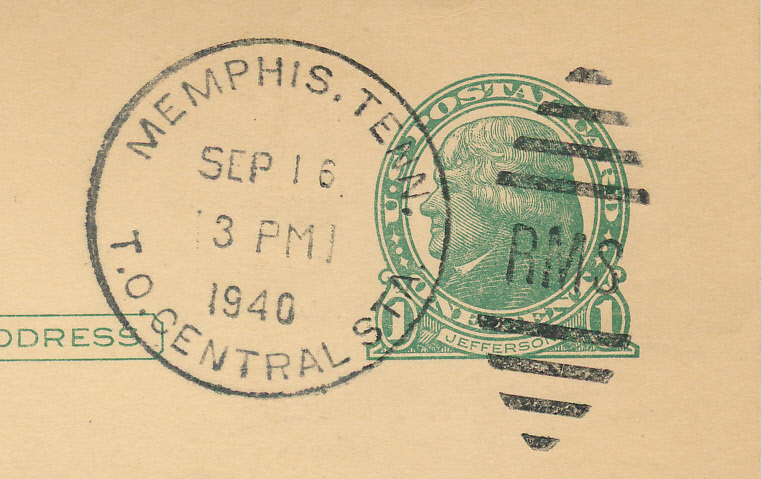

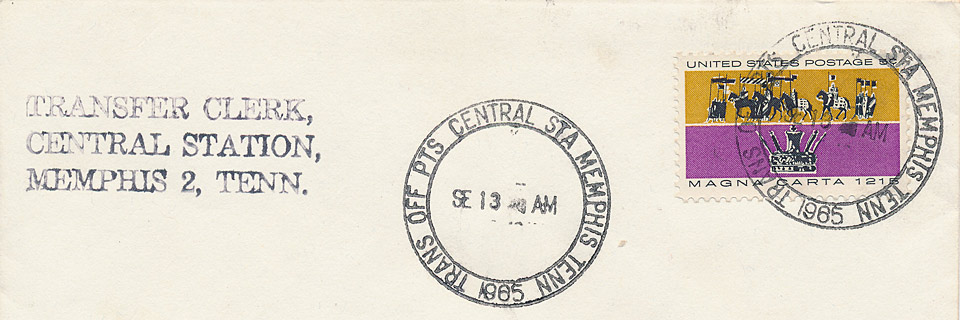
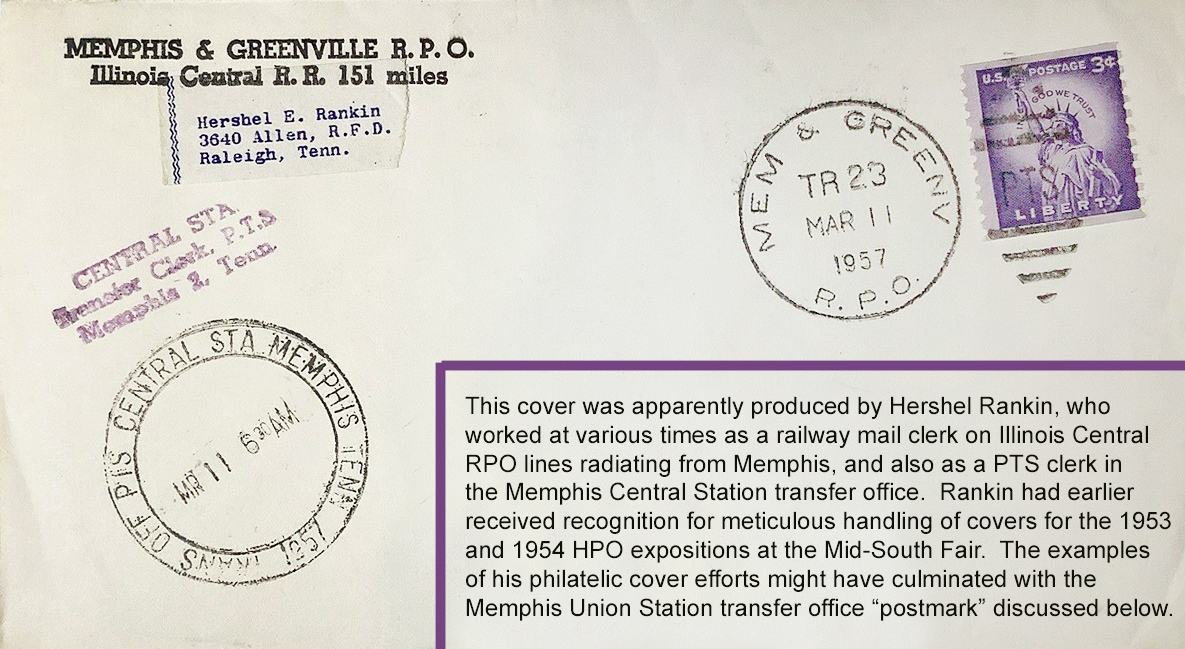
The absence of any Union Station transfer office postmarks is a curiosity, and at this point it cannot be definitively said whether or not a true Union Station cancel ever existed. Memphis Union Station closed on April 1, 1964 when passenger trains of all three tenant railroads were routed to other stations. The Union Station transfer office presumably closed at the same time. However, there are examples of Memphis Union Station transfer office philatelic covers with a provisional rubber stamp cancel dated November 10, 1964. All of these covers utilize the Homemakers 5-cent commemorative stamp which was issued on October 26, 1964. It is probable that these covers were produced after the fact, strictly for philatelic purposes, and thus do not represent mail actually canceled by the Union Station transfer office. See POD form 5118 from Memphis Central Station for an example of how a similar rubber stamp was actually used. A court order forced the reopening of Union Station in December 1966, but the Union Station transfer office was not reestablished.
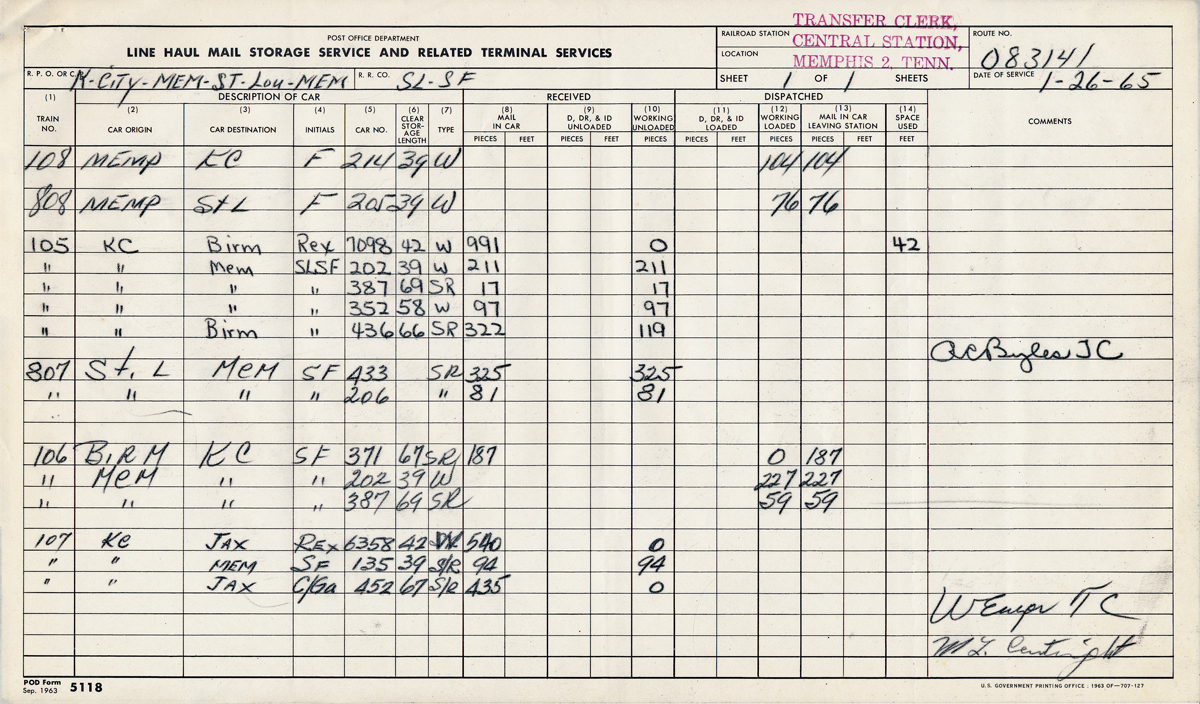

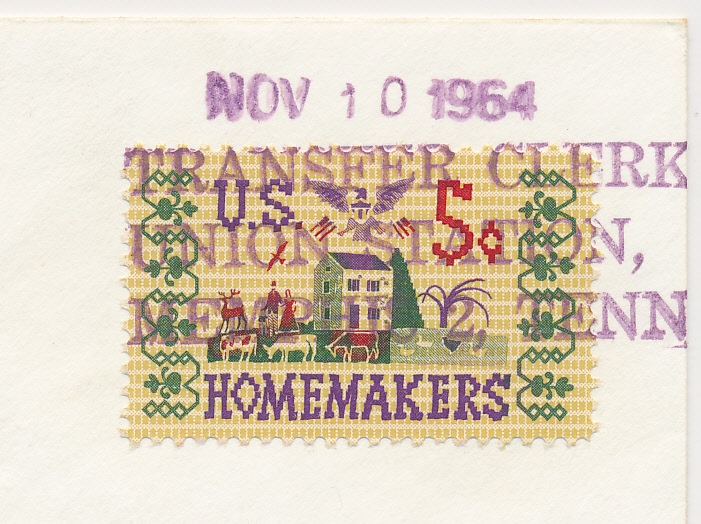
TERMINAL RPO
Although the Memphis terminal RPO was opened in November 1913, early examples of a postmark were unavailable for this article. During the time that the terminal RPO was merged into DeSoto Station, it is possible that the DeSoto Station postmark was used. With the separation of these facilities in 1924, separate Terminal RPO cancels were again used. These cancels lasted from the late 1920s into at least the mid-1950s before being replaced with a Terminal PTS cancel circa 1956.
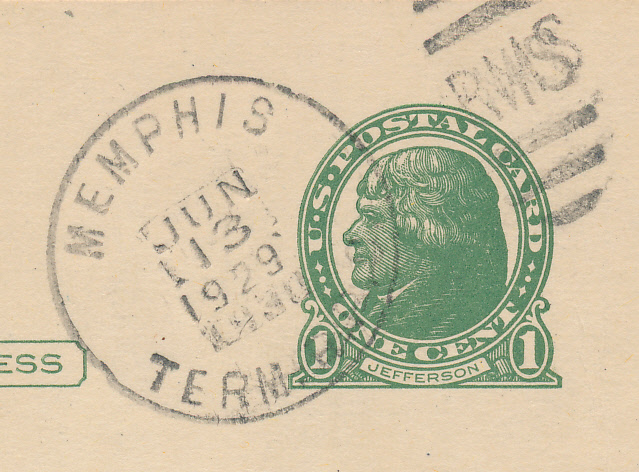
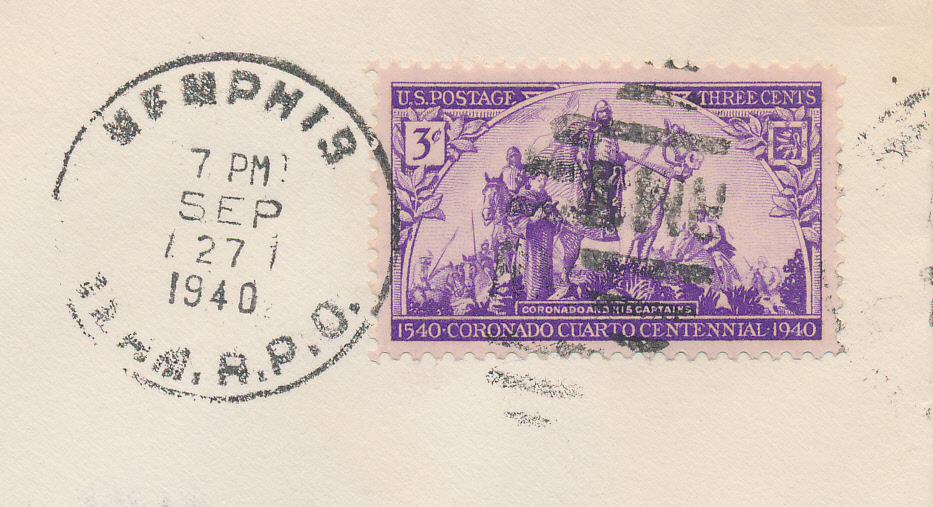
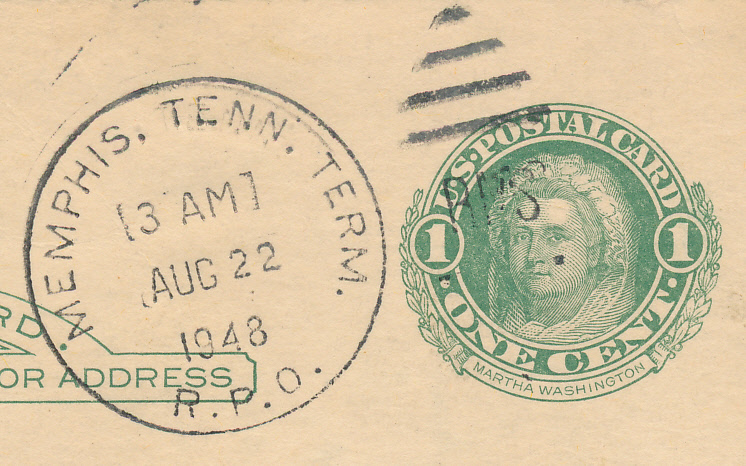
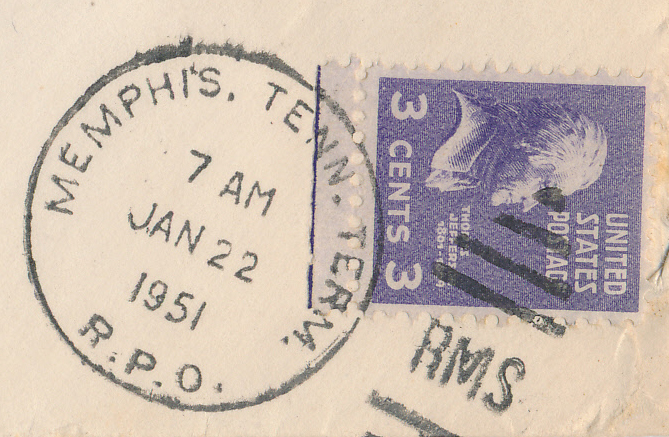
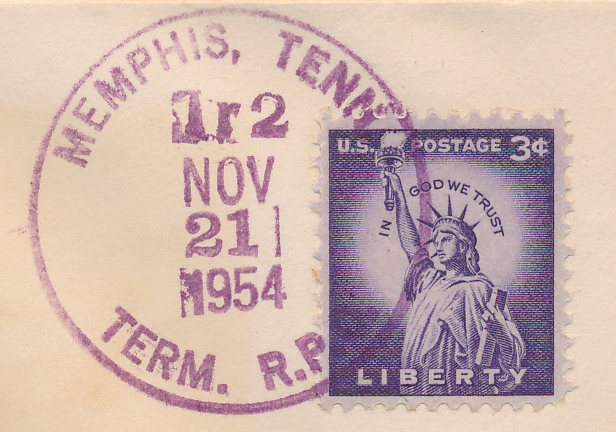
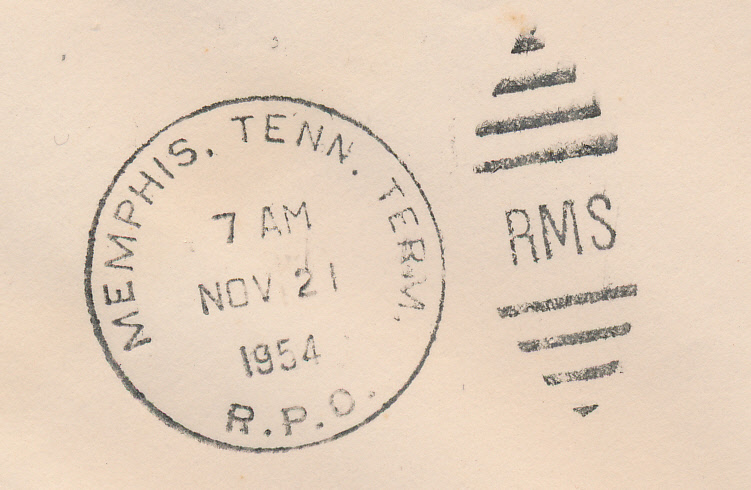
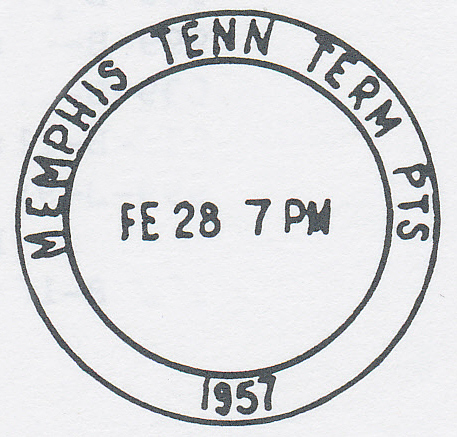
In the late 1950s and early 1960s, the general trend was to assimilate as much of the RMS/PTS operations as practical into the local post office management structure, and terminal RPO operations were primary targets for this consolidation. The pages below show the responsibilities of the Memphis Terminal when still at full operation in May 1959. In June, July and August of that year, segments of the operation were moved either to the DeSoto Station or to the Butler truck terminal, with notices provided in the weekly summary of schedule changes which were provided to PTS clerks.





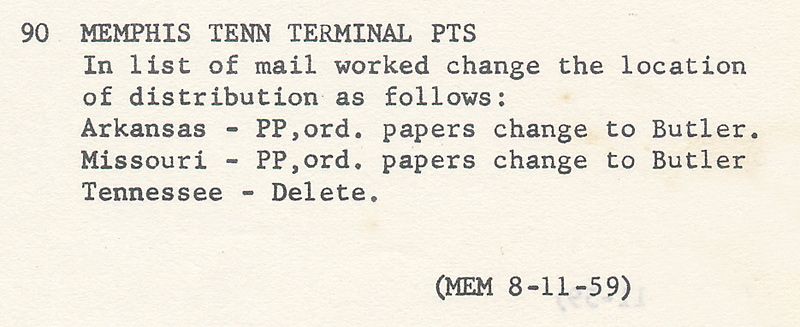
The reduced operations of the Memphis Terminal were reflected in a significantly reduced presence in the Memphis Region Schedule as demonstrated with the mid-August 1959 listing below. Remaining operations other than the transfer office were gradually shifted to other facilities. The Memphis PTS terminal became simply the Memphis Terminal in June 1960, along with other PTS terminals in the Memphis region. The "Memphis Terminal" name last appeared in the February 1961 schedule update, thereafter it was referred to as the Memphis bulk mail facility.
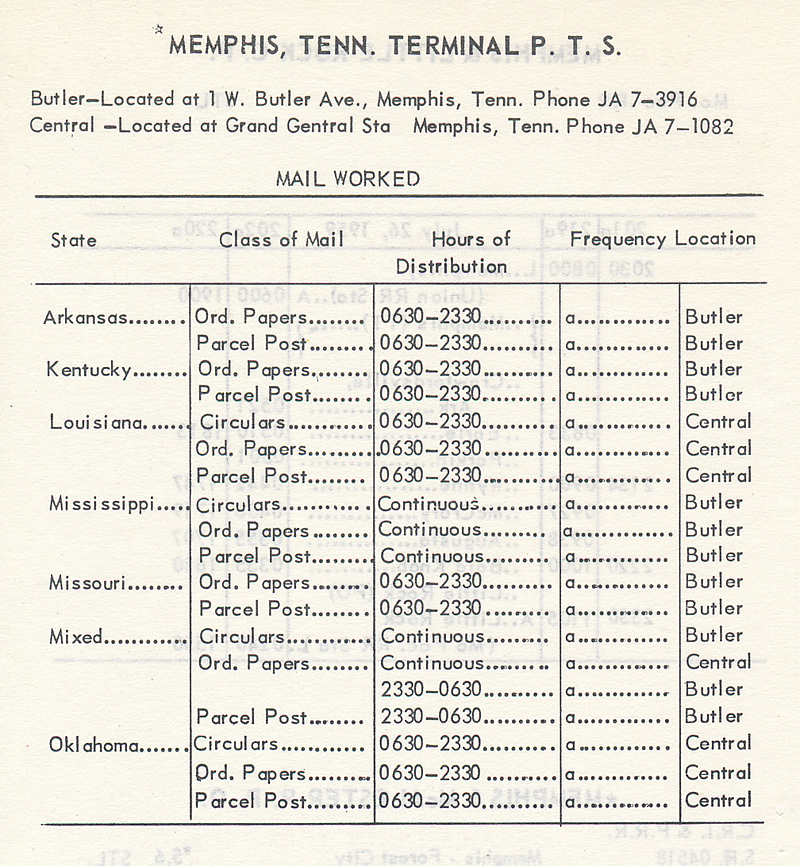
AIRMAIL OPERATIONS
The Memphis Municipal Airport was dedicated on June 14-15, 1929, with great fanfare and with considerable govenrment subsidy to underwrite the development of this new mode of transportation. Union Station and Central Station had been funded entirely by the host railroads, with property taxes generating considerable revenue for regional taxing authorities. The Municipal airport, on the other hand, was publicly funded with only minimal cost recovery from airline user fees, and the airport was viewed as public property, thus not subject to taxation. Airmail service to Memphis began in the early 1930s, invariably competing with existing Railway Post Office routes. It was common for special cacheted covers to be prepared for the first flights, and two of the earliest were routes 20 and route 33 which began serving Memphis on June 15, 1931. These special covers were initially canceled at DeSoto Station, some with hand cancels and others with machine cancels. An airfield office, staffed by RMS personnel, was opened at the Memphis municipal airport in mid-1946. In the 1940s and early 1950s, the cancel for Memphis AMF carried a RMS designation in the killer bars. By 1959-1960 the cancel style had evolved and the designation had become PTS. The numerous first trip airmail covers for Memphis offer collectors yet another area of postal transportation history in which to specialize.
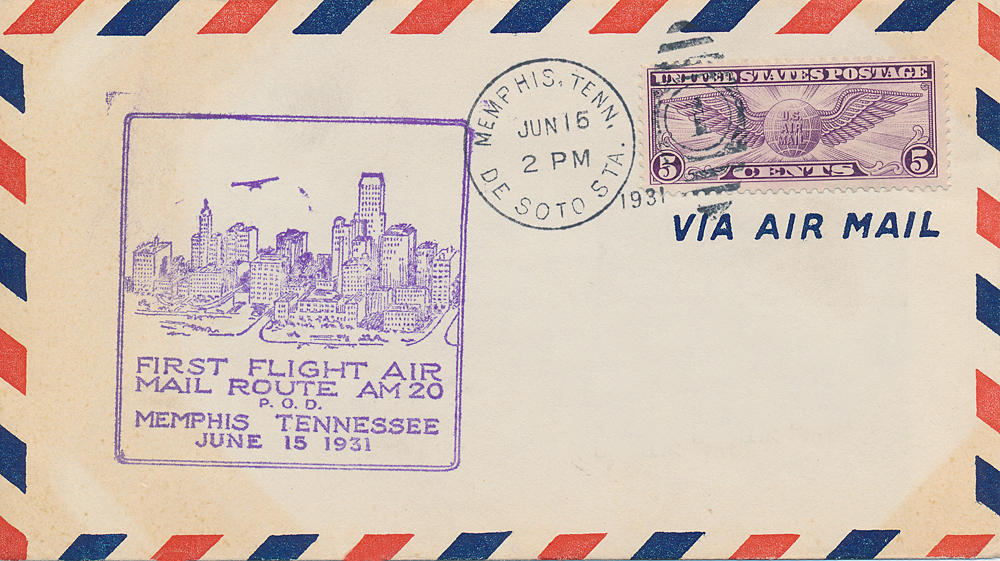
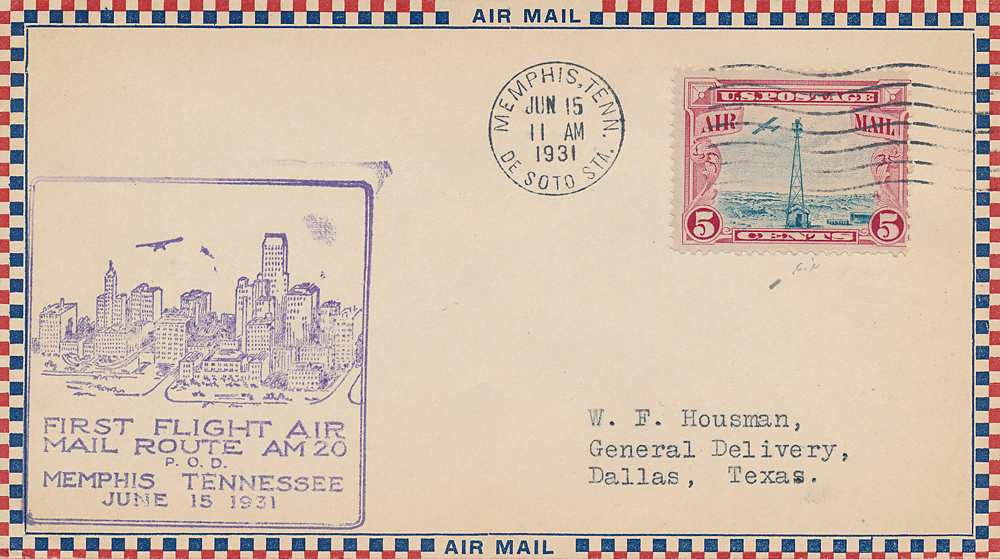
The two postmarks above illustrate DeSoto Station cancels, one a hand cancel and the other a machine cancel. It is noteworthy that almost all of these early airmail first trip covers were postmarked at DeSoto station rather than the main Memphis post office. From that, it appears that the mail transportation function of the post office at Memphis was largely handled through DeSoto Station.
The first cover below illustrates the Memphis Air Mail Field (AMF) postmark, which used a hand cancel device identical to those used by railway postal clerks. Note the "killer" section over the stamp contains the standard RMS - Railway Mail Service - initials. Clerks assigned to the AMF office were initally under the jurisdiction of the Railway Mail Service. The second cover below illustrates the PTS - Postal Transportation Service - version of the AMF postmark.
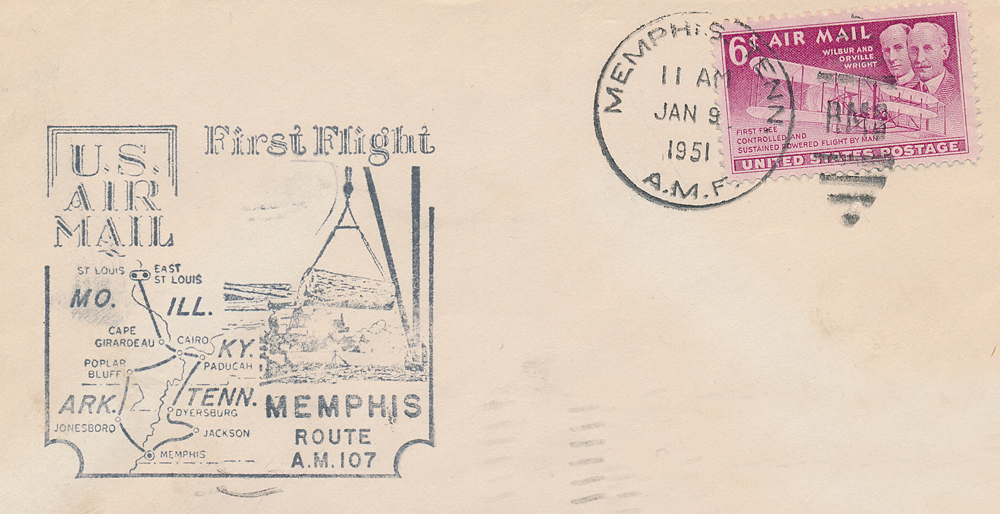
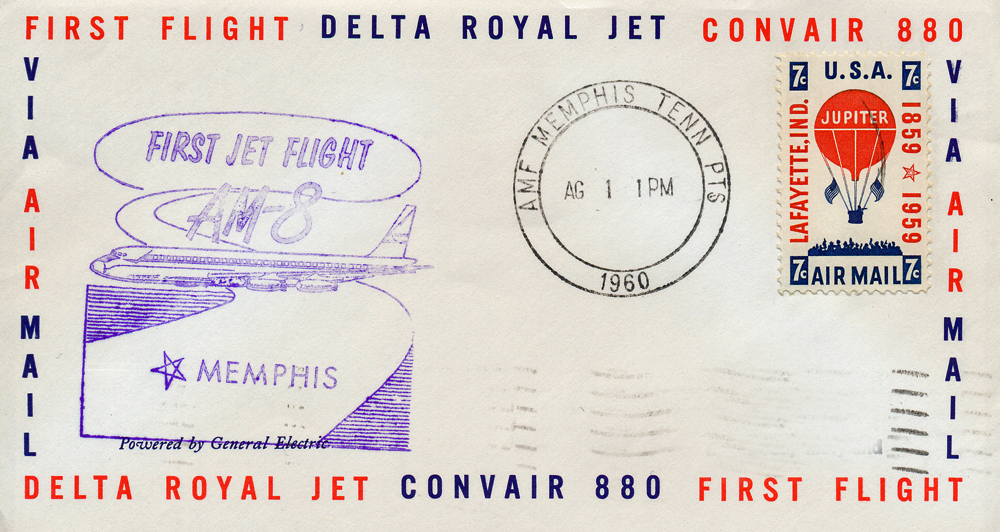
Into the early 1960s, there was close coordination between the airmail operation and conventional mail transportation options, notably railway post office routes. These March 24, 1959 entries appeared in the Memphis Region - Schedule of Mail Routes, and illustrate the close connections still utilized with all of the RPO lines radiating out of Memphis.
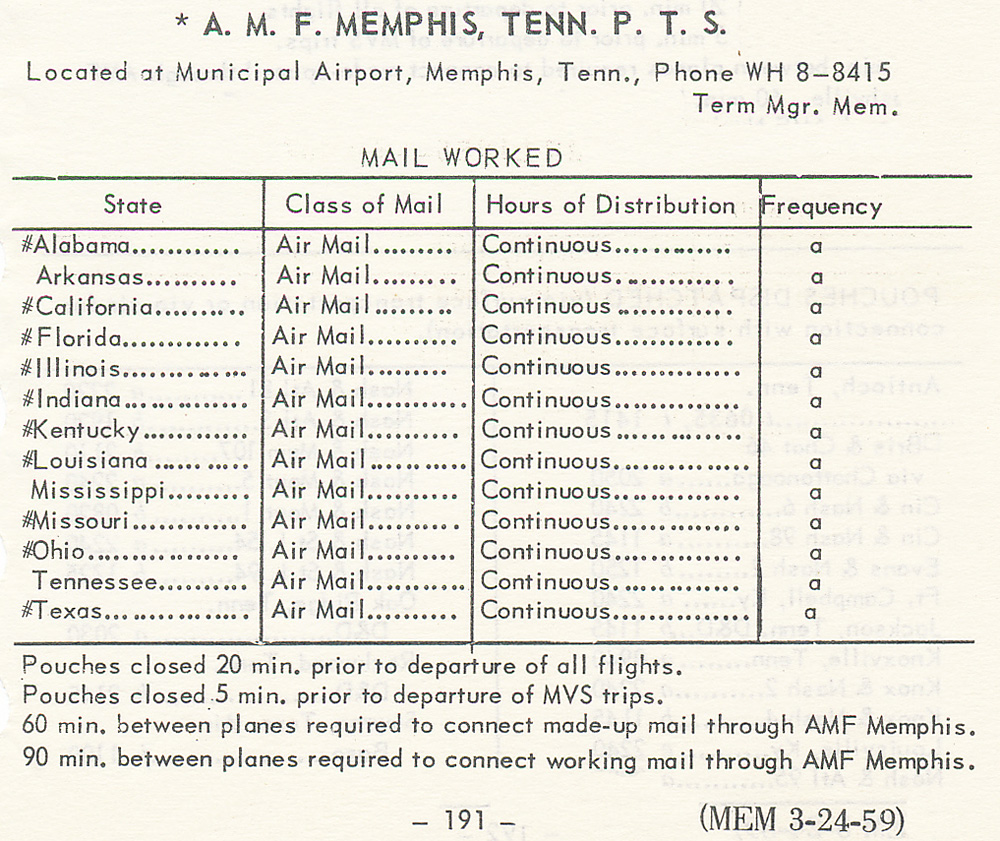
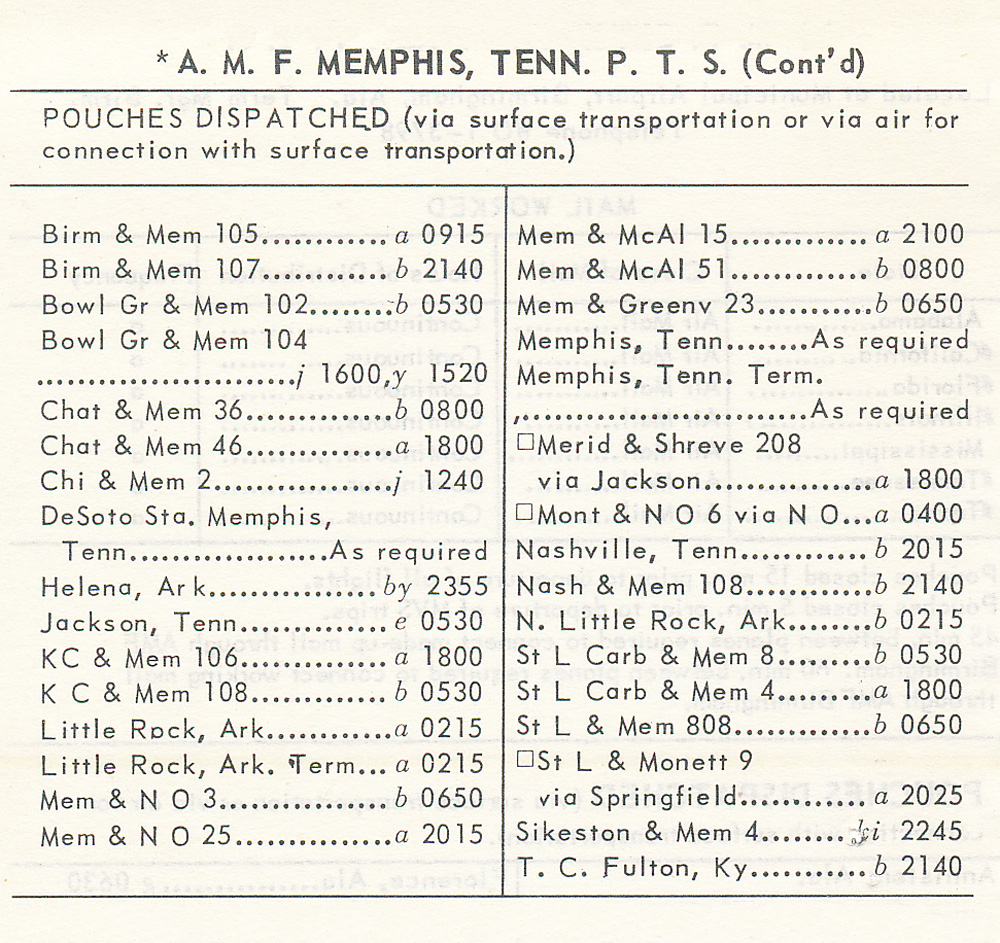
TRUCK TERMINAL
As highway transportation began to challenge rail's dominance in bulk mail transportation, a PTS truck terminal was established in Memphis in 1952. Beginning with PTS schedule #216, June 19, 1952, a separate Memphis Truck Terminal is shown as the departure point for a number of star routes, and over time, most other star routes originating at the Memphis terminal adjacent to Central Station were shifted to this new location. PTS truck terminal cancels are cataloged from 1953, but probably were in use from the time the facility opened in 1952. The March 1956 PTS schedule lists the truck terminal as Davis Station. From 1957 through late 1961, the truck terminal was located at 1 West Butler. From 1962 through July 1968 the PTS truck terminal was shown at the Butler Annex, 11 West Butler. By September 1968, the Butler annex had been closed and in 1968 and 1969 the truck terminal was identified as being at the Brooks Road Annex, 1894 Brooks Road. The Butler Avenue locations were in the immediate vicinity of other rail related postal transportation facilities, located approximately 2 blocks northwest of Central Station. The Brooks Road Annex, was located in south Memphis, less than a mile from the Memphis airport.
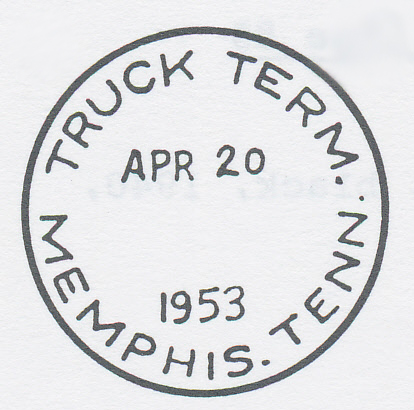
HIGHWAY POST OFFICE
Despite the large number of RPO routes radiating out of Memphis, the city saw only minimal HPO service. A HPO display unit did visit the Mid-South fair from September 24-October 3, 1953, and again September 25-October 3, 1954. Cancels from these special exhibits constitute part of the mobile post office cancels associated with Memphis. With the 1954 exhibit, the cancel from each day also carried a separate single-line stamp denoting the focus of each day (Cotton, Memphis, Livestock, Ladies, Arkansas, Mississippi, Childen, Armed Forces and Tennessee.) The 1953 exhibit was extensively covered in the October 1953 Postal Transport Journal, which reported that almost 7,000 covers were received from all parts of the world to be postmarked. The HPO was open from 10am to 10pm, with two tours of duty of 6 hours each, staffed entirely by volunteer clerks. Hershel E. Rankin, postal transportation clerk on the Memphis & New Orleans RPO [and founding member of the National HPO Society] served as chairman of cachet, postmark and mails, providing outstanding servicing of collector's mail. Due to his careful instructions regarding distinct postmarking and cacheting, the Memphis Branch received letters of appreciation from professional stamp collectors for the unusually clear, brilliant colors and stampings on their covers.
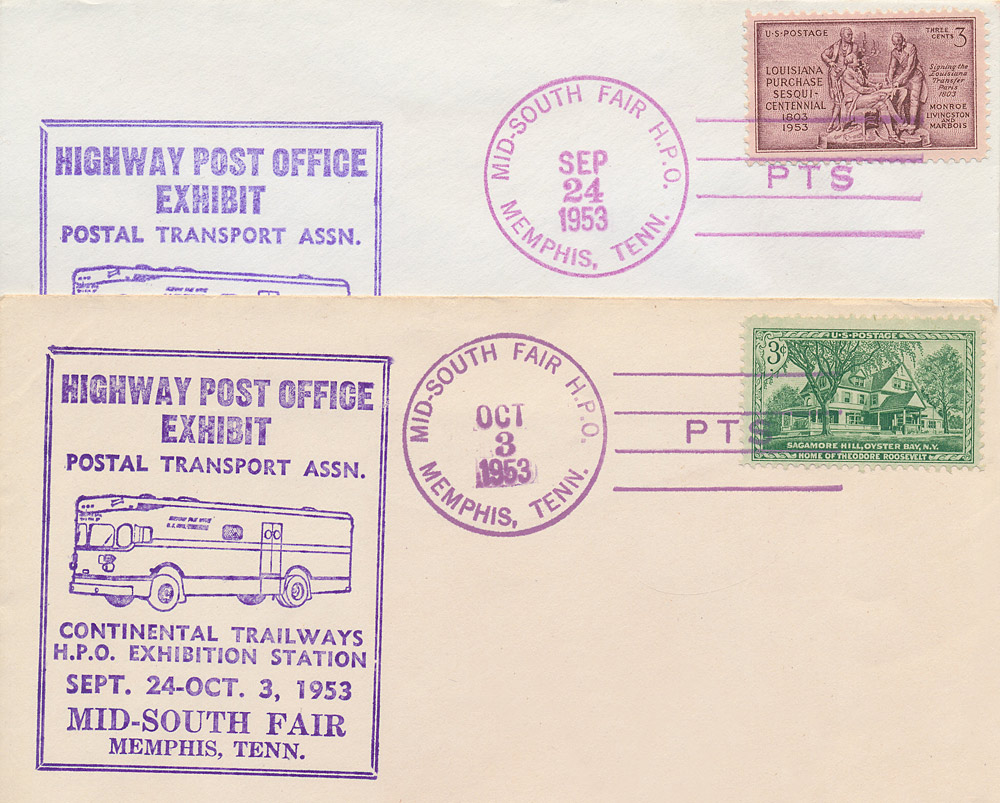
Disagreement between rail management and ten non-operating unions resulted in a strike on the Louisville & Nashville and the Nashville, Chattanooga & St. Louis starting March 14, 1955. From March 17 through May 11, substitute highway post office service was operated between Nashville & Memphis as trips 1-2 and trips 5-6 in lieu of the NC&StL trains which were not operating. The NC&StL trains were the same as the trip numbers; trains 1-2 were overnight trains and trains 5-6 were day trains between Memphis and Nashville. RPO cancel irons were used for these substitute highway operations, so there is no actual postmark record of this HPO operation other than an awareness of the dates of the rail work stoppage.
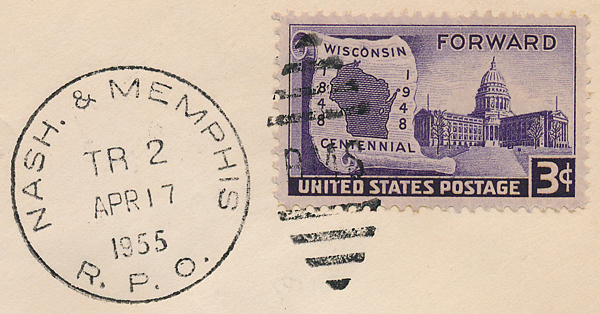
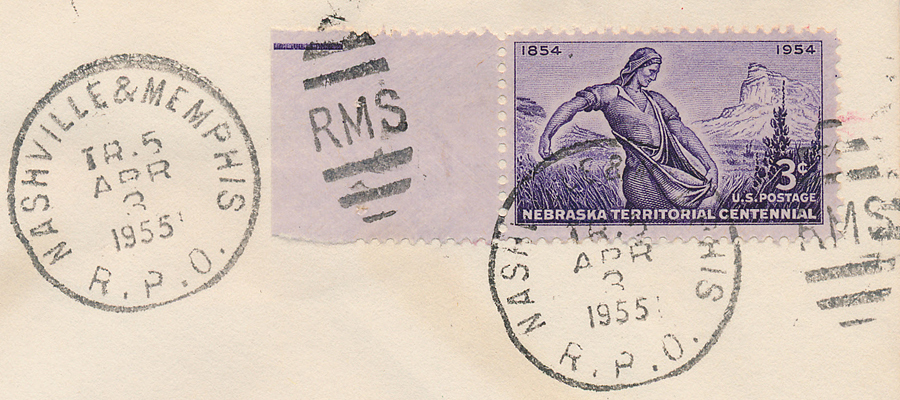
The only regularly scheduled HPO route serving Memphis was the Sikeston & Memphis HPO which was inaugurated on October 27, 1958 as a replacement for Frisco trains 805-806 between Memphis and St. Louis. This HPO originated and terminated at the Memphis truck terminal, but also made a brief stop at DeSoto Station. This route was discontinued October 18, 1968, the last mobile post office route serving Memphis. The West Memphis (Arkansas) & Little Rock HPO (June 1, 1965 - December 18, 1968) made up a pouch for DeSoto Station, but the HPO run actually terminated in West Memphis with a contract mail messenger handling closed pouches from West Memphis to DeSoto Station.
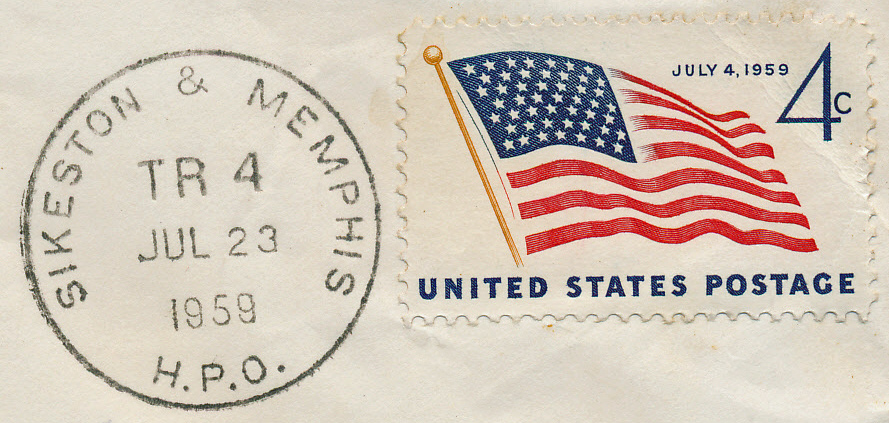
POSTSCRIPT
The 1960s were generally a period of dismantling the massive, precise network of the railway mail service as the post office shifted more to an operating system geared for volume rather than speed and precision. However, one incident helps illustrate the importance of railway post office cars even as late as 1966. On March 31, 1966, the Brotherhood of Railway Firemen and Enginemen called a strike against 38 railroads, including the Illinois Central, thus stalling passenger train service (and railway mail transportation) through Memphis. Mail service was disrupted to such an extent that the Memphis post office was forced to put on 60 extra men to handle the work normally done on railway mail cars.
Memphis Union Station, the largest stone building in Memphis, saw its last passenger trains in March 1968 and the property was subsequently cleared to make room for a large Post Office distribution facility which continues to operate on that site. The mail terminal at Central Station was similarly razed, and that area is now populated with high-dollar condominiums. DeSoto Station went through a period where the windows and doors were bricked in, closing most of the facility to the public. In recent years, however, the building has been restored, and the front part of the building once again functions as a branch post office.


DeSoto Station as it appeared in 2018, the last surviving building of the once massive railway mail transportation network in Memphis. Photos courtesy of Bill Strong.
I Remember... the Memphis Mail Terminal: In October 2007, an article detailing activity at the Memphis mail terminal was authored by Tom Parker and published in The Memphis Buff, the newsletter of the Memphis Chapter of the National Railway Historical Society. Tom, a retired Illinois Central employee, had started his railroad career in 1962 by working at the Mail Terminal. All of the employees actually sorting mail were postal employees (including some former railway post office clerks), but the employees loading and unloading mail from trucks and railroad cars were classified as mail handlers, employees of the Illinois Central. Follow this link to read the article. After reading the article, you may return to this page by closing that PDF file page.
Table of Memphis RPO and HPO Last Trips, 1950-1968
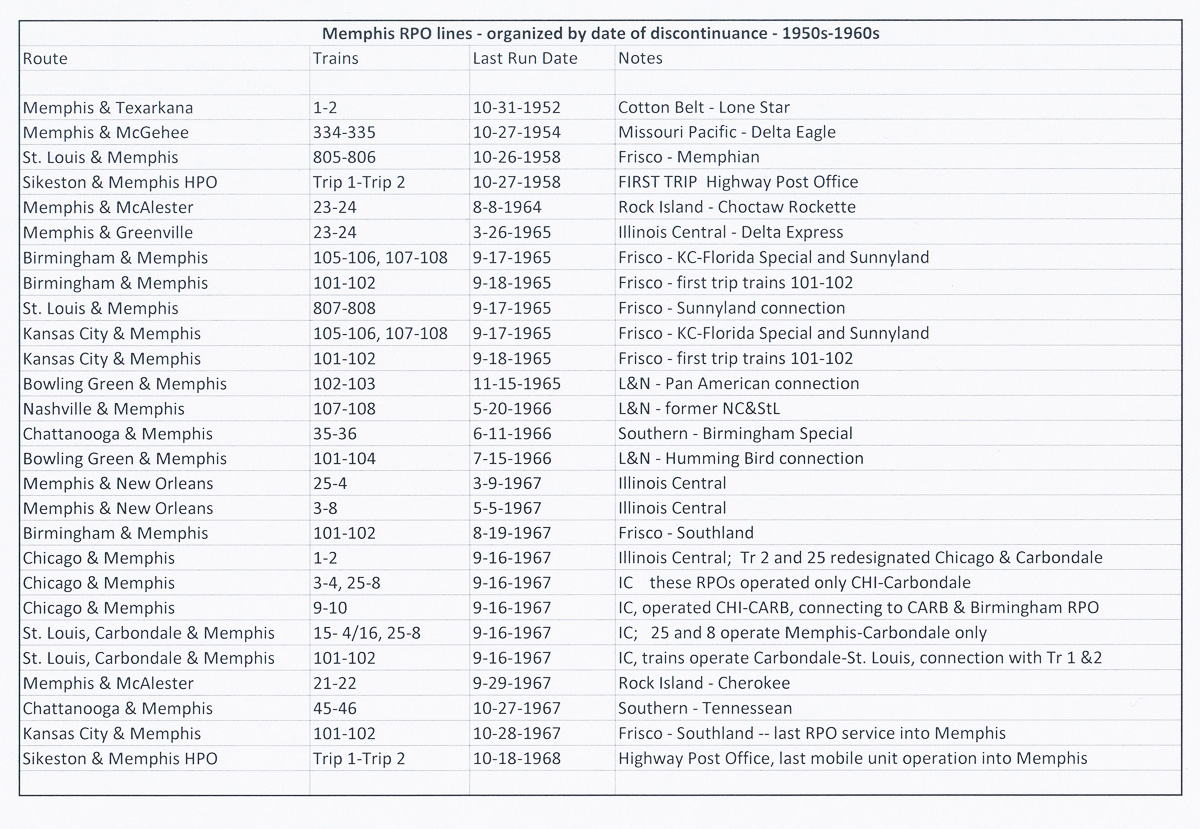
Return to Arkansas Railroad History home page








































